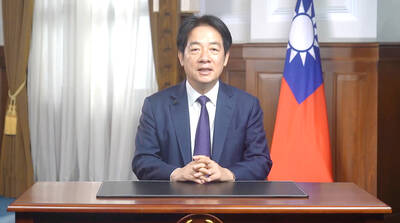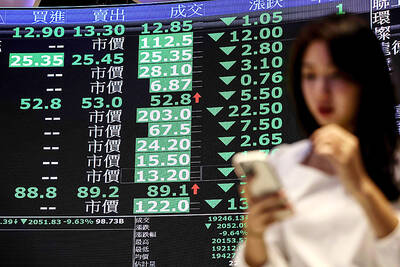A top national security official yesterday said China had begun deploying a new long-range ballistic missile aimed at Taiwan, adding that the missile’s destructive capacity went beyond that of the current missiles in China’s arsenal.
National Security Bureau (NSB) Director Tsai Der-sheng (蔡得勝) told the legislature’s Foreign Affairs and National Defense Committee that in addition to deploying the Dong Feng-16 (DF-16), the People’s Liberation Army (PLA) was also now fielding the DF-21, also known as the “aircraft carrier killer,” which could put any US Navy vessels coming to Taiwan’s assistance at great risk.
Asked by Chinese Nationalist Party (KMT) Legislator Lin Yu-fang (林郁方) whether the DF-16 was a completely new type of missile or a derivative of earlier Dong Feng types, Tsai said it was a whole new type.
“It’s more powerful, advanced and has a greater range than older types of Dong Feng missiles,” he said.
POTENTIAL TARGETS
Tsai said that while the DF-16 targeted Taiwan, it could also be used against other countries in the region. Those comments echoed a recent report by the non-profit global policy think tank Rand Corp on the Chinese ballistic missile threat, which listed Okinawa and Guam as potential targets. Both are home to large US military bases.
Testing of the DF-16 has been completed and the missile has been deployed, he said.
At present, China’s main arsenal threatening Taiwan consists of DF-11 and DF-15 short-range ballistic missiles based in Southeast China, with a range of 300km and 800km respectively.
Asked to comment on the possibility of the new deployment, Wendell Minnick, Asia Bureau chief for Defense News, said he suspected the DF-16 may be a DF-15 with extended range, adding that he found it very hard to believe that the US would not have noticed such a deployment.
SURPRISED
Turning to the DF-21, Lin said he was surprised to hear Tsai claim the DF-21 had been deployed.
Western countries have assessed that the PLA would need at least a decade before it could deploy the DF-21, because the technology required to hit a moving target at sea represents a substantial challenge, Lin said, adding that he was not aware of the DF-21 having been tested.
Tsai said that while Western countries relied on surveillance satellites to gather information on China’s weapons development, the bureau had a long-term focus on the development of human intelligence — that is, spies — to gather information.
US defense analysts estimate the DF-21 has a range of between 1,995km and 2,993km. Many commentators have called it a potential “game changer” that could threaten the US carrier fleet’s supremacy in the Pacific, a contention that remains disputed.
ADDITIONAL REPORTING BY J. MICHAEL COLE AND CNA

ACTION PLAN: Taiwan would expand procurement from the US and encourage more companies to invest in the US to deepen bilateral cooperation, Lai said The government would not impose reciprocal tariffs in retaliation against US levies, President William Lai (賴清德) said yesterday, as he announced five strategies to address the issue, including pledging to increase Taiwanese companies’ investments in the US. Lai has in the past few days met with administrative and national security officials, as well as representatives from various industries, to explore countermeasures after US President Donald Trump on Wednesday last week announced a 32 percent duty on Taiwanese imports. In a video released yesterday evening, Lai said that Taiwan would not retaliate against the US with higher tariffs and Taiwanese companies’ commitments to

Intelligence agents have recorded 510,000 instances of “controversial information” being spread online by the Chinese Communist Party (CCP) so far this year, the National Security Bureau (NSB) said in a report yesterday, as it warned of artificial intelligence (AI) being employed to generate destabilizing misinformation. The bureau submitted a written report to the Legislative Yuan in preparation for National Security Bureau Director-General Tsai Ming-yen’s (蔡明彥) appearance before the Foreign Affairs and National Defense Committee today. The CCP has been using cognitive warfare to divide Taiwanese society by commenting on controversial issues such as Taiwan Semiconductor Manufacturing Co’s (TSMC, 台積電) investments in the

HELPING HAND: The steering committee of the National Stabilization Fund is expected to hold a meeting to discuss how and when to utilize the fund to help buffer the sell-off The TAIEX plunged 2,065.87 points, or 9.7 percent, to close at 19,232.35 yesterday, the highest single-day percentage loss on record, as investors braced for US President Donald Trump’s tariffs after an extended holiday weekend. Amid the pessimistic atmosphere, 945 listed companies led by large-cap stocks — including Taiwan Semiconductor Manufacturing Co (TSMC, 台積電), Hon Hai Precision Industry Co (鴻海精密) and Largan Precision Co (大立光) — fell by the daily maximum of 10 percent at the close, Taiwan Stock Exchange data showed. The number of listed companies ending limit-down set a new record, the exchange said. The TAIEX plunged by daily maxiumu in just

‘COMPREHENSIVE PLAN’: Lin Chia-lung said that the government was ready to talk about a variety of issues, including investment in and purchases from the US The National Stabilization Fund (NSF) yesterday announced that it would step in to staunch stock market losses for the ninth time in the nation’s history. An NSF board meeting, originally scheduled for Monday next week, was moved to yesterday after stocks plummeted in the wake of US President Donald Trump’s announcement of 32 percent tariffs on Taiwan on Wednesday last week. Board members voted to support the stock market with the NT$500 billion (US$15.15 billion) fund, with injections of funds to begin as soon as today. The NSF in 2000 injected NT$120 billion to stabilize stocks, the most ever. The lowest amount it